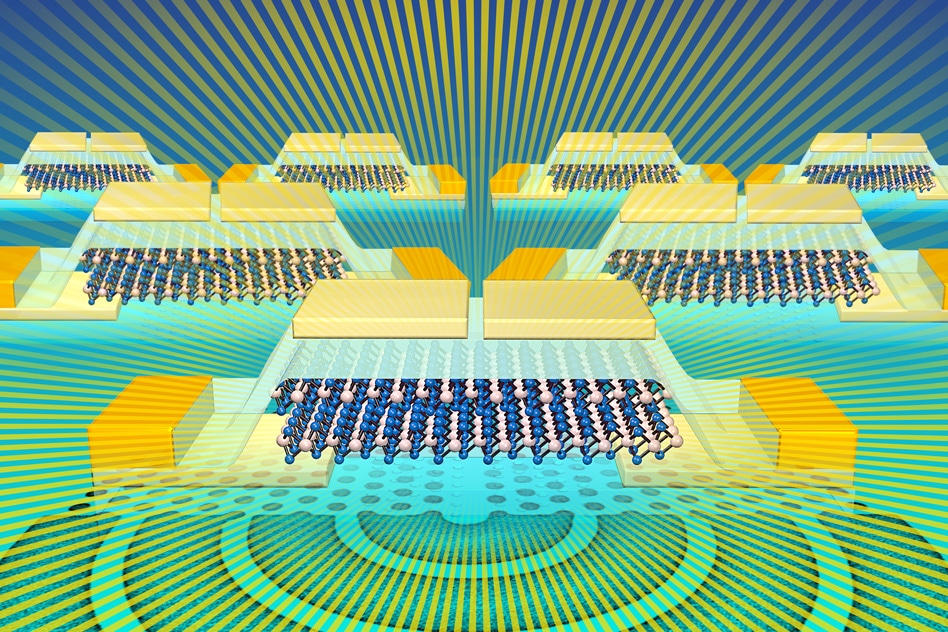Oct 24 2017
In recent decades, a vast increase in computing performance has been achieved by squeezing more and more transistors into a tighter space on microchips.
 Researchers have designed a light-emitter and detector that can be integrated into silicon CMOS chips. This illustration shows a molybdenum ditelluride light source for silicon photonics. Credit: Sampson Wilcox
Researchers have designed a light-emitter and detector that can be integrated into silicon CMOS chips. This illustration shows a molybdenum ditelluride light source for silicon photonics. Credit: Sampson Wilcox
However, this downsizing has also meant forcing the wiring inside microprocessors more and more tightly together, causing effects such as signal leakage between components, which can delay communication between different parts of the chip. This delay is known as the “interconnect bottleneck,” and it is becoming a growing issue in high-speed computing systems.
There is one way to handle the interconnect bottleneck, that is, to use light instead of wires to communicate between different parts of a microchip. However, this is not an easy task becuase silicon (the material employed to make chips) does not emit light easily, according to Pablo Jarillo-Herrero, an associate professor of physics at MIT.
Now, in a paper published in the Nature Nanotechnology journal on October 23, 2017, researchers explain how a light emitter and detector that can be incorporated into silicon CMOS chips function. MIT postdoc Ya-Qing Bie is the first author of the paper and he is joined by Jarillo-Herrero and an interdisciplinary group including Dirk Englund, an associate professor of electrical engineering and computer science at MIT
The device is made up of a semiconductor material known as molybdenum ditelluride. This ultrathin semiconductor is part of an emerging group of materials called two-dimensional transition-metal dichalcogenides.
According to Jarillo-Herrero, this material, unlike traditional semiconductors, can be stacked over silicon wafers.
“Researchers have been trying to find materials that are compatible with silicon, in order to bring optoelectronics and optical communication on-chip, but so far this has proven very difficult,” Jarillo-Herrero said. “For example, gallium arsenide is very good for optics, but it cannot be grown on silicon very easily because the two semiconductors are incompatible.”
Pablo Jarillo-Herrero, associate professor of physics at MIT
Unlike the gallium arsenide, the 2-D molybdenum ditelluride can be attached mechanically to any material, said Jarillo-Herrero.
Another problem with integrating other semiconductors with silicon is that the materials normally release light in the visible range, but at these wavelengths, light is simply absorbed by silicon.
Molybdenum ditelluride emits light in the infrared range, which is not absorbed by silicon, so it can be employed for on-chip communication.
In order to employ the material as a light emitter, the researchers initially had to convert it into a P-N junction diode, a device where one side, the N side, is negatively charged, while the other, P side, is positively charged.
This is typically performed by introducing chemical impurities into the material in traditional semiconductors. However, with the new type of 2D materials, it can be performed by just applying a voltage across metallic gate electrodes positioned side-by-side above the material.
“That is a significant breakthrough, because it means we do not need to introduce chemical impurities into the material [to create the diode]. We can do it electrically,” Jarillo-Herrero says.
Once the diode is generated, the investigators run a current through the device, making it to emit light.
“So by using diodes made of molybdenum ditelluride, we are able to fabricate light-emitting diodes (LEDs) compatible with silicon chips,” Jarillo-Herrero says.
The device can also be used as a photodetector by reversing the polarity of the voltage that is applied to the device. This makes it to stop conducting electricity until a light gets shone on it, when the current restarts.
In this way, these devices are capable of both transmitting and receiving optical signals.
The device is a proof-of-concept, and a huge amount of work still needs to be carried out before the technology can be developed into a saleable product, Jarillo-Herrero said.
This paper fills a significant gap in integrated photonics, by achieving a high-performance silicon-CMOS-compatible light source, said Frank Koppens, professor of quantum nano-optoelectronics at the Institute of Photonic Sciences in Barcelona, Spain, who was not part of the research.
This work shows that 2-D materials and Si-CMOS and silicon photonics are a natural match, and we will surely see many more applications coming out of this [area] in the years to come.
Frank Koppens, professor of quantum nano-optoelectronics at the Institute of Photonic Sciences in Barcelona
Now, the researchers are exploring other materials that could be employed for on-chip optical communication.
For instance, most telecommunication systems function using light with a wavelength of 1.3 or 1.5 micrometers, Jarillo-Herrero said.
However, molybdenum ditelluride could emit light at 1.1 micrometers. This makes it ideal for use in the silicon chips inside computers, but not appropriate for telecommunications systems.
“It would be highly desirable if we could develop a similar material, which could emit and detect light at 1.3 or 1.5 micrometers in wavelength, where telecommunication through optical fiber operates,” he says.
To this end, the investigators are researching into another ultrathin material known as black phosphorus, which can be set to emit light at different wavelengths by modifying the number of layers employed. They plan to develop devices with the required number of layers to enable them to emit light at the two wavelengths while at the same time remaining compatible with silicon.
“The hope is that if we are able to communicate on-chip via optical signals instead of electronic signals, we will be able to do so more quickly, and while consuming less power,” Jarillo-Herrero says.
Center for Excitonics, an EFRC funded by the U.S. Department of Energy, supported the research.